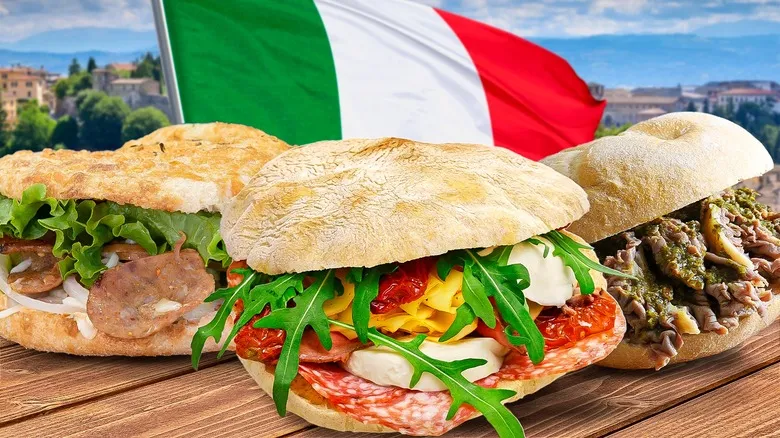Panino
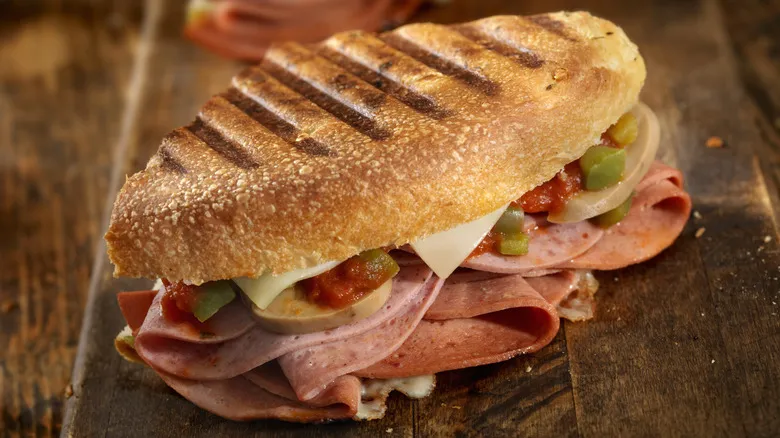
The panino, commonly known as panini in the United States, is an iconic Italian sandwich that won the affection of Italians in the mid-20th century, although its precise origins are somewhat ambiguous. This traditional dish, rooted in Italy's rich culinary heritage of bread and cured meats, gained popularity as a quick and satisfying lunch option in the bustling cafes and bars of cities like Milan and Rome. By the 1970s and 1980s, the panino had made its way across the Atlantic, establishing itself in the U.S. as a fashionable yet straightforward meal choice.
Throughout Italy, paninos are available in a wide array of styles. They can vary from a light, simple snack to a substantial meal, depending on the fillings and preparation methods. While each region adds its unique flair, the fundamental elements remain consistent: high-quality bread, such as ciabatta or focaccia; a selection of premium meats; and fresh, locally sourced ingredients. The use of regional cured meats like prosciutto highlights Italy's rich charcuterie tradition. When combined with cheeses like Fontina or Provolone and served on freshly grilled and pressed bread, the panino transforms into a delicious meal that embodies the spirit of Italian street food.
Panino con il lampredotto
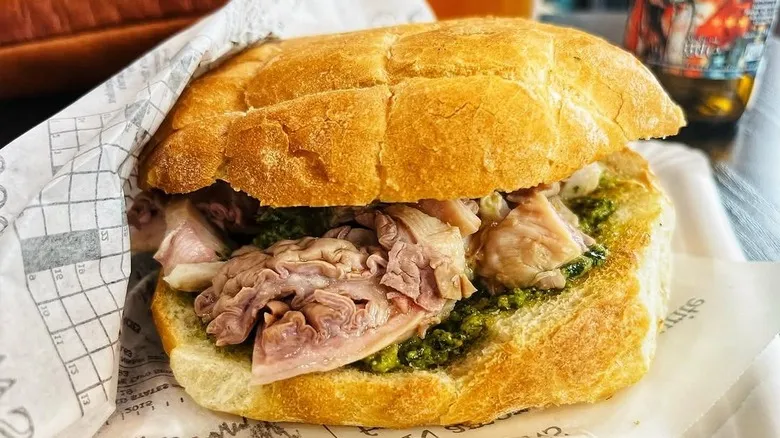
The panino con il lampredotto is a classic street food from Florence that may be a bit overwhelming for many American taste buds due to its robust flavor. This sandwich, made from cow's stomach, is a vital part of Florence's working-class culinary heritage. Its origins trace back to the late 15th century during the Renaissance, when it served as an affordable and hearty meal for laborers seeking a budget-friendly lunch.
To prepare lampredotto, the meat is slowly simmered with herbs and vegetables until it becomes tender. It is typically chopped and served in a soft roll, often paired with a spicy green Tuscan sauce that complements its unique taste. While it may seem daunting, locals regard it as a delicacy that embodies the city's nose-to-tail cooking philosophy—ensuring that nothing goes to waste.
More than just a dish, this sandwich is a cultural staple in Florence. Street vendors have been offering lampredotto for generations, and it remains a common sight at traditional food stalls throughout the city. For Florentines, the panino con il lampredotto is not an adventurous choice; rather, it is a beloved local classic that ties them to their culinary roots. Visitors who are open to trying it are rewarded with an authentic taste of Tuscan street food.
Porchetta di Ariccia

The quaint town of Ariccia, situated in the Lazio region close to Rome, is widely regarded as the birthplace of one of Italy's most cherished sandwiches: Porchetta di Ariccia. While the contemporary iteration of this pork sandwich is relatively recent, originating in the 1950s, the tradition of porchetta itself dates back to ancient Roman times.
The preparation of porchetta involves using a whole, boneless pork — usually from a young pig — which is carefully seasoned with a mix of herbs, including garlic, rosemary, salt, and pepper. The meat is then slow-roasted for several hours, resulting in a perfectly crispy skin while the inside remains tender and juicy. When sliced and served in a fresh roll, it embodies the essence of Roman countryside cuisine.
In Ariccia, porchetta is not just a dish but a cultural symbol that has been officially recognized with Protected Geographical Indication (PGI) status, ensuring that traditional preparation methods are maintained and honored. Today, it can be found throughout the country. In some regions, it is regarded as a delicacy (not typically served as a sandwich in these cases), while in others, such as Rome and its surroundings, it is enjoyed as everyday street food. Various regions have even created their own interpretations; for instance, in Umbria, porchetta is often stuffed with a mixture of pig innards, lard, and spices.
Puccia

The puccia sandwich hails from southern Italy, specifically the Salento region of Puglia, where a rich blend of Mediterranean flavors converges. While the exact origins of the sandwich remain somewhat unclear, it likely traces back to ancient Roman times when bread was a staple for the peasant population. Farmers required a hearty, portable meal to sustain them during long days of labor, leading to the creation of the puccia. Over the years, this sandwich has transformed from its humble beginnings, particularly after its modernization in the 1970s, evolving into a beloved street food that draws both locals and tourists eager to savor authentic regional cuisine.
The bread is the heart of the sandwich—a round, thick loaf with a crispy crust and a soft, hollowed-out interior, making it an ideal container for various fillings. The ingredients can vary significantly, often influenced by the season and local produce. For example, a puccia might be filled with fresh local cheeses, cured meats, ripe tomatoes, or even seafood caught that very morning. In the quaint towns throughout Salento, bakeries and street vendors each offer their unique take on this classic sandwich.
5 e 5

Pronounced "cinque-e-cinque" — the Italian way of saying the number five — the name of the 5 e 5 sandwich reflects both its ingredients and their original price. Originating from Livorno in Tuscany, the 5 e 5 primarily features a chickpea fritter and a bread roll, each sold for five lire back in the 1930s. What started as an economical meal for workers and students has evolved into a delectable piece of Tuscan culinary history.
The highlight of the sandwich is the "torta di ceci," a chickpea pancake made from chickpea flour, water, olive oil, and salt. The batter is cooked in a large copper pan until it achieves a golden, slightly crispy exterior. When served in a soft roll, it transforms into a delicious and satisfying meal that showcases the ingenuity of Tuscan street food. In the lively markets and street corners of Livorno, you can still find vendors crafting these sandwiches using techniques that have been handed down through generations, creating a tasty connection to the city’s heritage.
Panuozzo
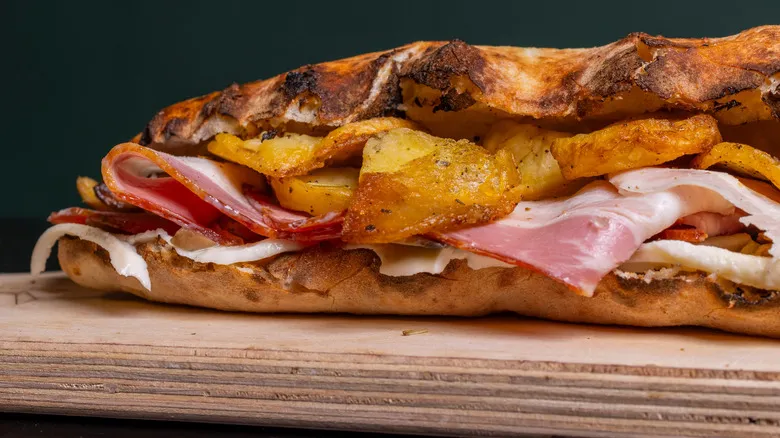
The panuozzo, created in the early 1980s by Giuseppe Mascolo in Gragnano, Italy, is a sandwich crafted from pizza dough. Mascolo aimed to develop an alternative to traditional pizza, and after some experimentation, he perfected the panuozzo. This unique creation involves baking pizza dough into a loaf, which is then sliced open and filled with ingredients such as local cured meats, cheeses, and vegetables. Gragnano, a town near Naples renowned for its pasta production, gained fame for this culinary innovation, which Mascolo patented to preserve its authenticity.
Making a panuozzo requires patience and attention to detail. The process starts with traditional pizza dough, shaped into a long oval and baked in a wood-fired oven until it turns golden. The loaf is then cut open and filled with various ingredients before being briefly returned to the oven. This second baking melds the flavors together and ensures the sandwich is served warm and crispy.
Initially available only at Pizzeria Mascolo, the panuozzo quickly became popular throughout Campania, establishing itself as a staple of the region's street food. Today, numerous variations exist, ranging from classic recipes to contemporary interpretations. Despite its widespread popularity, purists maintain that the most authentic experience can only be found at the original pizzeria in Gragnano. Regardless of the different forms it takes in today’s culinary landscape, the panuozzo remains a symbol of Gragnano's food heritage and a must-try dish for anyone visiting the region.
Cuzzetiello

The cuzzetiello is a classic Neapolitan street food crafted from the crusty end of cafone, a traditional regional bread. Historically, families would scoop out the bread and fill it with leftovers from Sunday dinners, turning simple scraps into a flavorful and satisfying meal. This creative use of leftovers highlights Naples' rich culinary heritage and ingenuity.
This food tradition is closely tied to Naples' "fare la scarpetta" culture, where diners use bread to soak up every last drop of sauce from their plates. Initially, the cuzzetiello served as a smart solution for working-class families to minimize waste. The tough end of the bread, often too hard to enjoy on its own, became a delightful vessel for rich, slow-cooked ragù and tender meatballs, sometimes even while still simmering in the pot.
Over the years, the cuzzetiello has transformed from a practical way to use leftovers into a beloved street food. While traditional versions still pay homage to the original recipe of ragù and meatballs, modern variations have emerged, featuring fillings like friarielli (broccoli rabe) and sausage, eggplant parmigiana, or creamy mozzarella with cured meats. Street vendors and small eateries throughout Naples regularly serve this sandwich, ensuring it remains a vibrant and integral part of the city's culinary identity.
Tramezzino

The tramezzino originated from the lively café scene in Turin in 1926, crafted by Angela Demichelis Nebiolo at the Mulassano Café. More than just a sandwich, it signified a fresh approach to light, quick meals in Italy. Initially referred to as paninetto, it was renamed tramezzino after Gabriele D'Annunzio, a renowned writer and regular customer, remarked that its triangular shape reminded him of the tramezze, or partition walls, in his home. The name also reflected its function as a snack enjoyed between traditional meal times.
Often likened to an Italian version of the tea sandwich, the tramezzino is distinguished by its use of crustless white bread, which was rare in Italy at the time. This soft bread replaced the more rustic Italian loaves, providing a smooth, delicate texture that beautifully complemented the refined fillings, such as butter and anchovies.
The tramezzino's versatility—ranging from simple tuna or egg fillings to more elaborate gourmet options—has solidified its place in Italian culinary culture. Today, this elegant sandwich remains a favored snack throughout Italy, frequently enjoyed alongside aperitivo drinks like the negroni or spritz, highlighting its enduring connection to social and leisurely dining traditions.
Pani ca' meusa

Nestled along Sicily's northern coast, Palermo has historically served as a melting pot of Mediterranean cultures, with influences from Arab, Norman, and Jewish traditions shaping its unique character. One of the city's most famous street foods, pani ca' meusa, exemplifies this diverse cultural heritage. This sandwich, made from fried veal spleen and lung, was first crafted in the late 19th century by Jewish butchers in Palermo who were compensated with animal organs and entrails. They transformed these less sought-after cuts into a delicious delicacy that quickly became a beloved local dish.
To prepare this street food classic, the organ meats are meticulously cleaned, simmered until tender, and then sautéed in lard. The savory filling is served in a sesame seed bun, often garnished with grated caciocavallo cheese, a squeeze of lemon, and a sprinkle of salt. Pani ca' meusa is a common sight in Palermo's vibrant street markets, which play a vital role in the city's culinary scene.
The flavors of pani ca' meusa are undeniably rich, owing to the use of organ meats, so it's essential to approach the sandwich with an open mind. If you're eager to give it a try, be ready to visit Palermo, as this local favorite is difficult to find outside the city.
Mozzarella en carrozza
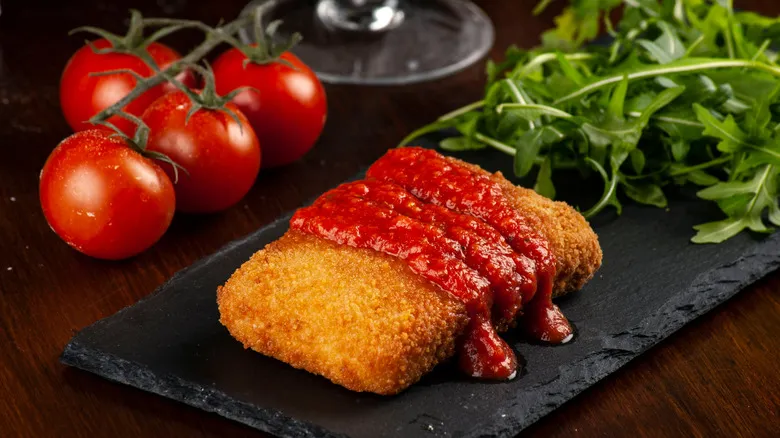
Mozzarella en carrozza, which translates to "mozzarella in a carriage," is a beloved Italian comfort dish that dates back to the 19th century. The name whimsically implies that the mozzarella is being transported by the bread, adding a playful twist to the concept. While the precise origins of this dish are somewhat unclear, it is generally thought to have originated in the Campania region of southern Italy. Originally, it served as a practical and economical way for working-class families to utilize leftover bread and cheese. Over the years, its popularity soared, and it became a cherished dish throughout Italy, with various regional adaptations of the basic recipe. For instance, in Venice, you might encounter mozzarella en carrozza paired with anchovies or prosciutto.
This sandwich features fresh mozzarella typically nestled between slices of thick Italian bread, which is then dipped in egg and fried until golden and crispy. Despite its modest beginnings rooted in thriftiness, mozzarella en carrozza has evolved into a comforting dish enjoyed by people from all walks of life in Italy and beyond. If you're looking to try mozzarella en carrozza in the U.S., seek out an authentic Italian restaurant that offers more than just the standard pizza and pasta options.
Piadina

The piadina, a type of unleavened flatbread, boasts a history that dates back to ancient Rome. The form we know today began to emerge in the 14th century in the Emilia-Romagna region of northern Italy. During this period—particularly following the plague around 1300—the peasant population could not afford leavened bread. They turned to simpler fare such as polenta, barley flour, and unleavened cakes made from more common grains and legumes. This transition marked the beginnings of what would evolve into the modern piadina, made from readily available ingredients like wheat flour, water, salt, yeast, and a touch of lard. The dough is rolled out thin and cooked on a griddle, resulting in its characteristic golden-brown spots.
In the early 20th century, the piadina saw a significant resurgence, largely due to the introduction of corn flour. This new blend with soft wheat flour made the piadina even more cost-effective to produce while preserving the quality and flavor that had made it a beloved staple.
Today, piadina is commonly filled with ingredients such as soft cheeses, cured meats, and fresh vegetables. It has evolved beyond a simple sustenance to become a delightful delicacy found in restaurants throughout Italy. In Emilia-Romagna, piadina is particularly ingrained in the region's street food culture, attracting both locals and tourists alike.
Recommended

The History Behind The Mississippi Sandwich That Anthony Bourdain Called 'Hard To Beat'

What Makes A New Jersey-Style Sloppy Joe Different From All The Rest?

How Montana Became Home To The Oldest Chinese Restaurant In The Country

The Important Role Gullah Cuisine Plays In South Carolina Food History
Next up

